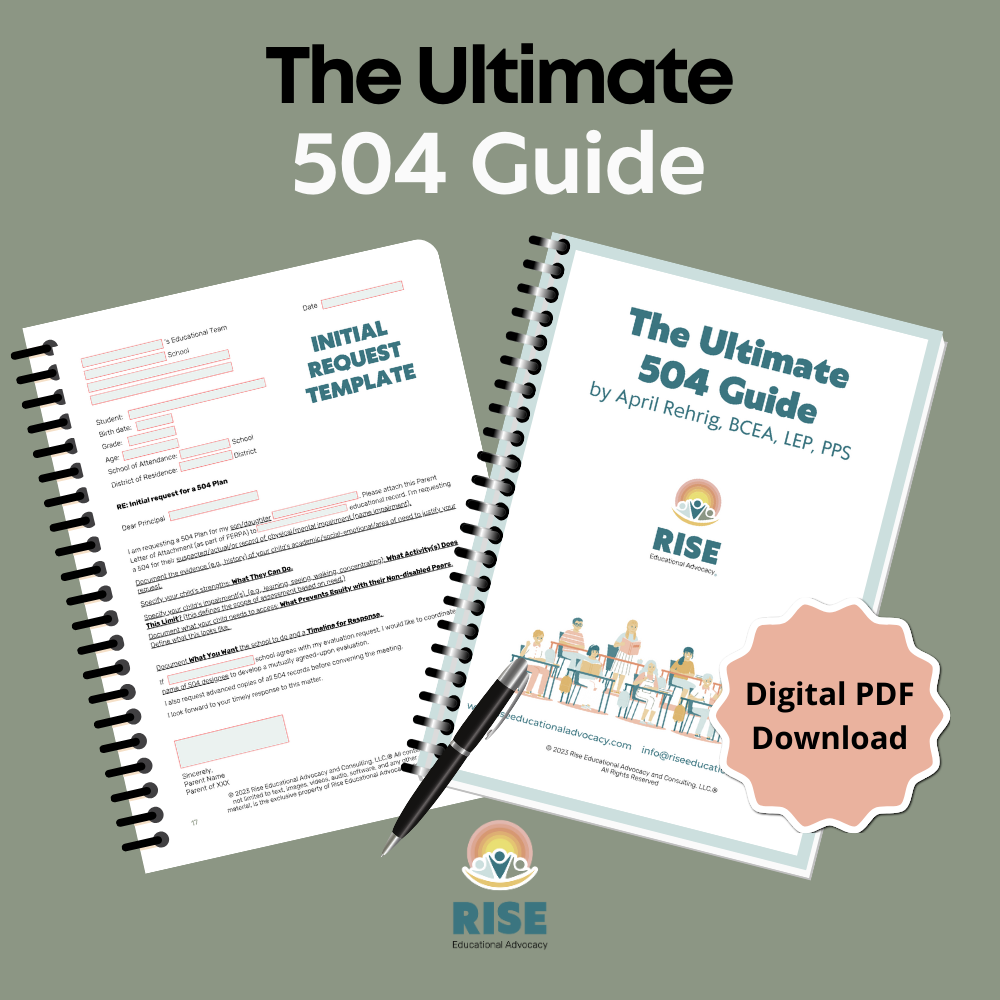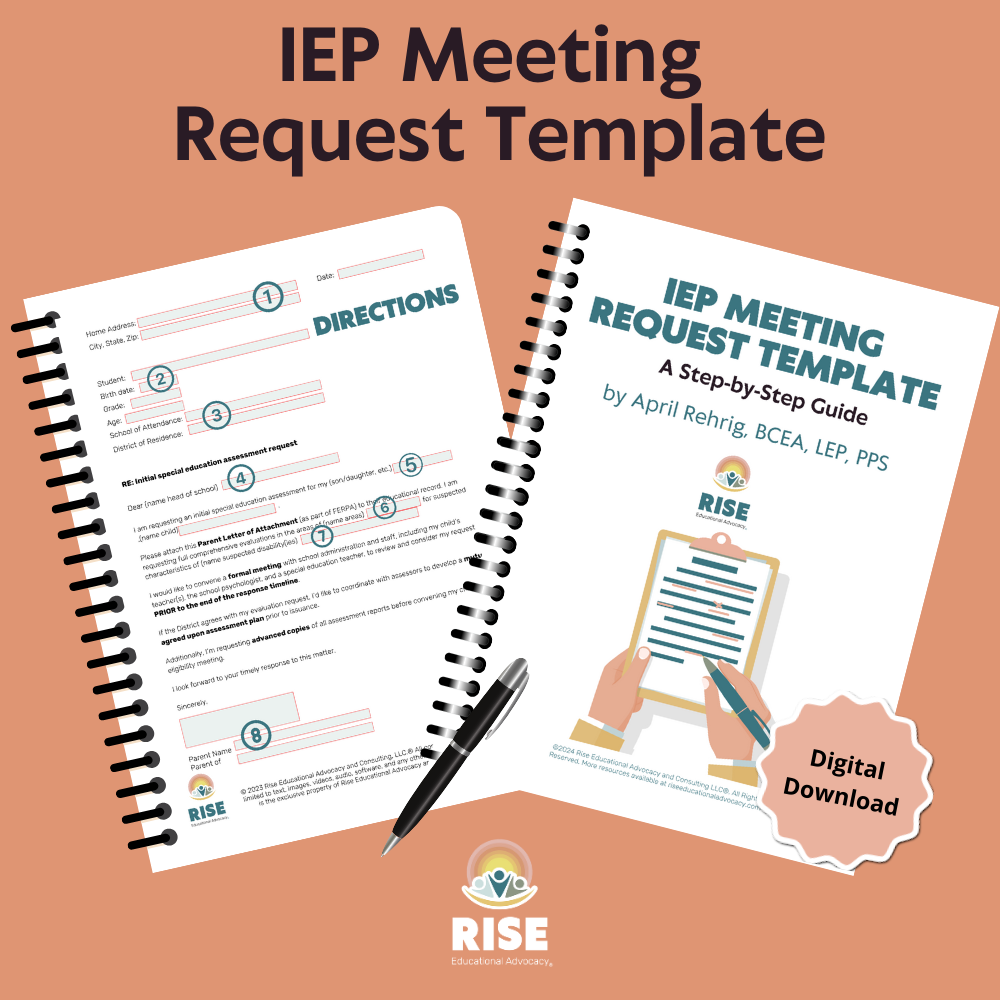
IEP vs 504 Plan: Understand the Difference and Choose Right
As a parent, few things weigh on your heart like watching your child struggle in school.
You want to provide the best possible support, but the world of education plans can be a bewildering labyrinth. Let's highlight two common paths within this maze: an Individual Education Plan (IEP) and 504 Plan.
Want to Learn More About the Differences in IEP and 504 Plans?
Click below to get our Eligibility Comparison Guide.
What Is an IEP? - Blueprint for Success
 Imagine the IEP (Individual Education Plan) as a carefully crafted roadmap charting your child's educational journey. It is a legally binding document detailing educational goals, objectives, and related services specifically tailored to your child's unique needs. Essentially, they determine HOW schools address the needs identified in the evaluation report(s). It’s considered a “working“ document and is revised and changed, as needed, in response to a student’s progress and needs.
Imagine the IEP (Individual Education Plan) as a carefully crafted roadmap charting your child's educational journey. It is a legally binding document detailing educational goals, objectives, and related services specifically tailored to your child's unique needs. Essentially, they determine HOW schools address the needs identified in the evaluation report(s). It’s considered a “working“ document and is revised and changed, as needed, in response to a student’s progress and needs.
An IEP is not a contract but a statement produced by the school at the end of a formalized collaborative process defining appropriate special education and/or related services. IEPs establish the school’s accountability in developing and implementing the education plan. Professionals, including educators, parents, and relevant individuals, develop plans, all bound by the Individuals with Disabilities Education Act (IDEA). The IEP team determines HOW the school will address needs identified in the evaluation report(s). Read our blog 👉 5 Ways to Build a Better IEP®.
Get our FREE Eligibility Guide
The 504 Plan - Equalizing the Playing Field
Now, shift your focus to the 504 Plan. Unlike the IEP, the 504 Plan isn't about specialized education but ensuring equal access to education and school programs for students with disabilities. It is rooted in Section 504, a civil rights statute enacted in 1973 that prohibits discrimination and guarantees equal educational opportunities. The 504 Plan identifies how the school will provide support and remove barriers to learning, allowing your child to thrive alongside their non-disabled peers.
 Where They Converge - Free Appropriate Public Education (FAPE)
Where They Converge - Free Appropriate Public Education (FAPE)
The IEP and 504 Plan share a common foundation - providing a Free and Appropriate Public Education (FAPE). This means schools must offer an education that addresses your child's unique needs, preparing them for further education, employment, and independent living.
Eligibility - A Tightrope Walk
What Qualifies for an IEP?
Here's where the paths diverge. To qualify for an IEP, your child must meet at least one of the 13 stringent eligibility criteria outlined in IDEA, in addition to state-specific criteria. Eligibility encompasses a “three-part test”. Students must first meet eligibility as an Individual with Exceptional Needs (IWEN). Second, their disability must adversely impact their educational performance. Lastly, students must require special education or related services to access the core curriculum. This is a high bar to clear, and knowing 👉 How to Request Testing makes all the difference.
What Qualifies for a 504?
In contrast, a 504 Plan doesn't hinge on federal or state regulations. It simply requires your child to have an actual, suspected, or record of physical/mental impairment (a medical diagnosis is not required). Their impairment must substantially limit one or more “major life activities.”
These may include things such as learning, seeing, hearing, walking, standing, breathing, concentrating, thinking, communicating, and caring for oneself or a “major bodily function” such as dysfunction of the immune system, cell growth, digestive, bladder, neurological, brain, respiratory, circulatory, endocrine, and reproductive functions. Criteria for a 504 Plan are more flexible, accommodating a wider range of impairments, even those that may be episodic.
The Rare Overlap - Dual Support
Can you have an IEP and a 504 plan? Surprisingly, your child may be eligible for both, depending on their needs and applicable laws and regulations. Having both plans is uncommon. Most families choose an IEP over a 504 Plan for specialized academic instruction, goals, and more robust support.
504 and IEP Teams & Timelines - The Planning Process Unveiled
Developing an IEP and a 504 Plan involves different teams and timelines. For an IEP, a team of special education teachers, providers, general education teachers, and a Local Education Agency (LEA) designee convenes at least once a year. They also conduct triennial assessments to determine continued eligibility, following strict IEP timelines for evaluations and meetings.
In contrast, there's no fixed blueprint for a 504 Plan team. Typically, these plans are developed by a school administrator or 504 coordinator, the teacher, the student, and the parent(s). The flexibility in team composition can be both an advantage and a challenge, depending on your child's specific needs.
 Assessment - Unveiling the Evaluation Process
Assessment - Unveiling the Evaluation Process
Evaluations are crucial in both plans. IEP assessments often involve a process known as Child Find. Under this provision, districts must "search and serve" students with suspected and/or actual disabilities. 👉 Special Education Assessments can be formalized and lengthy, including standardized tests and rating scales, to gather comprehensive information.
On the other hand, a 504 evaluation is not required. If an assessment is completed, it generally relies on existing school data, such as grades, teacher feedback, attendance records, and data from Multi-Tiered Systems of Support (MTSS) or Response to Intervention (RTI) tiers. This non-formalized approach streamlines the process and provides quicker support without the added timeline of special education assessments.
Services - Crafting the Support Network
One of the most significant distinctions lies in the services offered. An IEP provides substantially more robust services, including specialized academic instruction and specific educational goals and objectives. Progress under an IEP is closely monitored, focusing on achieving individualized milestones.
In contrast, a 504 Plan generally keeps instruction within the general education setting, supplemented by accommodations and supplementary aids and services. While it doesn't provide the same level of specialized instruction as an IEP, it's crucial to note that students with 504 Plans can receive modifications to address their unique learning needs.
Age - Beyond the School Years
Regarding the 504 or IEP age range, IDEA law mandates that public schools provide special education services to eligible students from ages 3 to approximately 22, depending on state rules. Essentially, students can qualify for an IEP from pre-kindergarten through high school graduation or until they age out of special education services.
On the other hand, 504 Plans extend to preschool eligibility but offer opportunities for post-secondary institutions and adult schools. However, it's essential to recognize that the application, eligibility criteria, and service plan rules undergo substantial changes for adult students, marking a transition beyond the K-12 educational landscape. Read our blog 👉 High School vs. College Disability Support.
 Parent Notice - Keeping You Informed
Parent Notice - Keeping You Informed
Both plans prioritize keeping parents informed, but they do so through different mechanisms. For IEPs, schools must provide written notice before changing a child's services or placement, known as Prior Written Notice (PWN). Written notifications are also standard for 👉 IEP Meetings and evaluations. Parents have "stay put" rights to maintain current services during resolution if a dispute arises.
While written notice isn't mandated for 504 plans, it is generally accepted practice to inform parents about evaluations or "significant changes" in placement. However, formal Prior Written Notice (PWN) is not required for 504 Plans.
Funding - Who Bears the Cost?
A key consideration for parents is funding. Under IDEA, the federal government and state funds are allocated for special education services, with school districts responsible for providing services. In other words, specialized services under an IEP are funded through federal and state resources.
Conversely, accommodations and modifiggggggcations outlined in a 504 Plan are typically funded through the school's regular operating budget, often referred to as the general fund. This can be an important factor when evaluating which plan best suits your child's needs.
As you stand at the crossroads of the IEP and 504 Plan, remember that your child's unique needs and the legal requirements surrounding these plans will guide your decision. It's a complex landscape to navigate, but you are better equipped to make an informed choice with knowledge about the eligibility criteria, teams, timelines, assessments, services, age considerations, parental notice, and funding.
Ultimately, both paths aim to support your child's education, helping them overcome challenges and reach their full potential. Your journey as a parent navigating these educational plans is a testament to your dedication to ensuring the best possible future for your child. That dedication is a source of inspiration for us all.
We’re Here to Help
You are not alone. A wealth of IEP and 504 resources is available to guide everyone through the educational maze.
The journey may seem overwhelming, but with persistence, resilience, and the right support, your child or student will overcome the challenges that come their way.
At Rise Educational Advocacy®, we provide expert-approved Parent IEP Coaching, DIY Workshops, and virtual services nationwide. We help families and teachers successfully navigate IEP and 504 Plans for K12 students and beyond. Get started 👉HERE.


